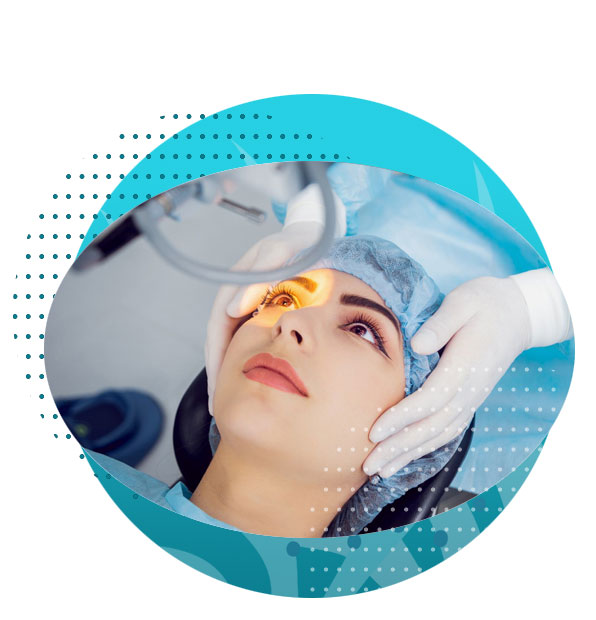Childhood Eye Conditions
Normal Visual Development in children
Lazy eye, refractive error and squint in childhood need early assessment and continuous monitoring to ensure the preservation of good ocular alignment and vision.
We are born with a wonderful visual equipment set that includes:
- the sensory system – the two eyes, that focus and detect light and patterns and translate the light impulses into nervous activity;
- the motor system – 12 ocular muscles (6 for each eye) that move the eyes in a coordinated way;
- the brain, the organ which registers and interprets vision and controls and coordinates the motor and sensory systems.
These act as a harmonious whole to enable meaningful vision.
The eye of a newborn baby is mostly fully developed at birth, but the brain is still in a very plastic stage and still needs to ‘learn’ to see and interpret the visual world. So the eye muscles don’t act to coordinate eye movements at birth.
A newborn baby will have relatively poor vision, equivalent to the top line on a visual acuity chart. The reason for this is that most newborn babies are markedly longsighted and the focusing mechanism of their eyes is not yet fully developed.
They are also unable to control their eye movements, so it’s not at all uncommon for babies less than a month old to have a squint or appear to have somewhat roving eye movements. By the sixth week of life, these focusing and eye movement mechanisms are starting to mature and the connections between the eyes and the visual parts of the brain are also beginning to develop.
By the 8th-10th week of life, babies should be starting to smile at familiar faces and be able to “fix” their eyes on an object of interest and to “follow” this object if it moves from side to side.
If you notice that this might not be occurring you may consider seeking a medical opinion.
How the brain impacts childhood vision
Neural connections continue to evolve in response to visual input from both eyes, in much the same way as with speech and language. The ‘plastic’ period for speech and language acquisition is up until 8-12 years of age. After this, it becomes progressively more difficult for instance to learn a new language. Visual development is similar.
The brain requires equal focused input from two eyes and good alignment of the two eyes stabilised by the ocular muscles during the developmental or plastic stage. If the two eyes are not properly aligned, or if there is a large difference in refractive error between the two eyes, it is possible for the brain to make use of the input from one eye at the expense of the other eye, allowing one eye to lose its competitive advantage. This is what we refer to colloquially as a ‘lazy’ eye. It could be that the ‘lazy’ eye is in fact normal, but the brain has merely not learnt to use the information from this eye. Treatment is aimed at redressing this imbalance.
For this reason, it’s important to attend to childhood eye conditions in a timely fashion. If the eyes are not properly aligned at birth, commonly known as a squint, this needs to be assessed and treated appropriately and early. It’s also important that children be screened at 3.1/2 to 4 years of age, before starting school. This is when a child is generally cooperative enough to assess acuity of vision and refractive error, but while there is still sufficient brain plasticity to correct the situation with glasses and occasionally patching of one eye to allow the brain to learn to see equally well with each eye.
If there is any concern about an infant’s or child’s eyes or vision, it is important to seek ophthalmic consultation.
You may like to learn more about childhood conditions from the Squint Clinic.
Nasolacrimal duct obstruction
An infant with a discharging or watery eye could have a blockage of the tear drainage duct. The tear drainage duct leads into the nasal cavity. The entrance into the nose is covered by a very thin membrane which generally opens shortly after birth. If this membrane persists longer, then the infant develops to hearing and some time secondary infection and discharge.
This is generally remedied by lacrimal sac compression and antibiotic eye drops. Sac compression is a technique that needs to be carried out correctly. Your ophthalmologist can carry this out or teach this to the parents. If this measure does not remedy the issue, then sometimes probing of the tear duct can be carried out in the operating theatre

Pediatric Eye Examination
We pride ourselves in high level of patient care, aiming to provide each patient with individualised attention from your first consultation and well beyond your eye surgery recovery.
WORKING HOURS
ASHFIELD EYE CLINIC
Located conveniently in the centre of Ashfield (opposite the Holden Street entrance to Ashfield Mall), the clinic is only 5 minutes from the train station.
Ground Floor, 2 Holden St
Ashfield, Sydney, NSW 2131



